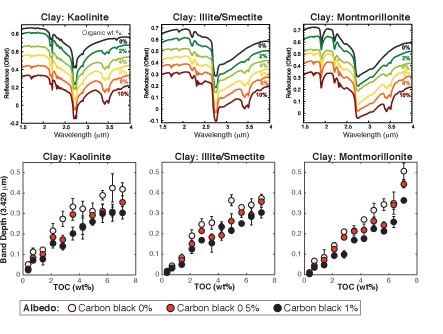2015 Annual Science Report
 Massachusetts Institute of Technology
Reporting | JAN 2015 – DEC 2015
Massachusetts Institute of Technology
Reporting | JAN 2015 – DEC 2015
Mars Analog Studies: Reflectance Spectroscopy of Organics in Ancient Rocks and Meteorites
Project Summary
Aside from laboratory analyses of meteorites and in situ measurements by mass spectrometers on rover and lander platforms, the search for extraterrestrial organic material on Mars, carbonaceous© chondrite parent bodies, and other planetary surfaces is primarily limited to remote sensing techniques. Our team has been exploring the use of visible and near-infrared reflectance spectros-copy for assessing the presence and abundance of organic materials preserved in ancient terrestrial rocks and C chondrite meteorites. We have continued a series of controlled laboratory experiments to analyze (1) a suite of isolated kerogens and ancient terrestrial sedimentary rocks from various depositional environments and (2) several suites of synthetic clay-organic mixtures. Our goal is to better characterize the potential of reflectance spectroscopy as a method for organic detection and quantification in planetary environments, with the benefits that this technique is rapid, non-destructive, and applicable at laboratory, rover and orbital scales. The spectral models we are de-veloping will provide a foundation for quantifying organics that may be observed in spectroscopic data returned by the Hayabusa2 and OSIRIS-REx missions, laboratory spectra of C chondrites, and future Mars missions equipped with imaging spectrometers.
Project Progress
Our group continues to explore the limits on detection and quantification of organic carbon using visible-near-infrared (VIS-NIR) reflectance spectroscopy applied to both natural sedimentary rock samples and synthetic mixtures of organics and clay. Our primary focus has been on the ~0.3-5 µm wavelength range because it includes a variety of absorptions that are diagnostic of organic compounds and minerals (including clay minerals, Fe-oxides, carbonate, sulfates) and because it overlaps with a range spanned by a number of past, current, and future spectrometers on planetary missions.
Natural samples include a suite of clay-rich Mesoproterozoic shales from the McArthur basin and kerogen isolated from these samples. We seek to understand how reflectance spectra of kerogens vary with composition and maturity (e.g., H:C ratio) and how these spectral properties are modified in the presence of minerals, as is the case for C chondrite meteorites and organic-bearing sedimentary rocks. We have adapted a radiative transfer (Hapke) model to fit the laboratory spectra of bulk rock powders using mineral and organic spectral endmembers (Fig. 1). The output of the model includes estimated abundances of organics and individual minerals, which can then be compared to independent estimates of total organic carbon (TOC via an Elemental Analyzer) and modal mineralogy (from X-ray diffraction). Current results indicate that organic abundances estimated from reflectance spectra are linearly correlated to TOC values (Fig. 2), suggesting this is a viable technique for quantifying organic content of clay-rich samples. These terrestrial samples contain significant fractions of phases that are largely non-absorbing at these wavelengths, thus current work is focused on recasting TOC abundances in terms of weight percent of spectrally dominant phases. Early results indicate that this correction shifts spectrallyderived estimates of organic content closer to a 1:1 line when plotted against TOC. Current work is now focused on applying these methods to terrestrial samples that are mineralogically more similar to C chondrites (e.g., serpentine-rich samples) and to mudstone samples measured by the Curiosity rover on Mars.

We have also synthesized and measured several suites of clay and organic mixtures to explore competing effects that are likely to affect spectral detection and quantification of organic matter in sedimentary rocks. This work consisted of 108 samples that systematically controlled and varied clay type, water content, and albedo, all of which can affect the spectral shape and strength of organic absorptions. Findings from this laboratory study, currently in review at Clays and Clay Minerals, indicate that the strength of organic absorption features are linearly related to the total organic carbon content of the sample for TOC <8 wt.% (Fig. 3). Albedo of the sample has a significant influence on this relationship, but we demonstrate that this can be minimized by using radiative transfer models to convert reflectance spectra to single scattering albedo spectra. We have also found that clay type (expandable versus non-expandable) and water content have a weaker influence on detectability of organics, an important result for planetary applications where these factors may vary widely or be poorly constrained. Of the natural and synthetic samples measured thus far, spectra for the lowest TOC (~0.08 wt.%) sample exhibit clear C-H absorptions near 3.4 µm. This indicates a lower limit of detection is below this value, and ongoing measurements of low TOC samples will help us to refine detection limits of reflectance spectroscopy when applied to organic-bearing rocks and sediments. The focus of current and future work is to apply these techniques to C chondrite meteorites and to determine the degree to which reflectance spectra can also be used to assess H:C and aromatic:aliphatic ratios in sedimentary rocks. The results of this project indicate that VIS-NIR reflectance spectroscopy is a viable method for quantitative detection and mapping of organics in terrestrial and planetary materials. This method is particularly well suited for studies that require remote, rapid, and/or non-destructive techniques.

Publications
- Kaplan, H. H. and Milliken, R. E. (2015), Visible-Near Infrared Reflectance Spectroscopy as a Non-Destructive Tool for Quantification of Organic Compounds in Sediments, Astrobiolo-gy Science Conference, Abstract #7426.
- Kaplan, H. H., and Milliken, R. E. (2015), Assessing organic content of sediments with reflec-tance spectroscopy: Analysis of natural samples and laboratory mixtures, 46th Lunar and Planetary Science Conference, Abstract #1220.
-
PROJECT INVESTIGATORS:
-
PROJECT MEMBERS:
Hannah Kaplan
Co-Investigator
Andrew Knoll
Co-Investigator
-
RELATED OBJECTIVES:
Objective 2.1
Mars exploration.
Objective 4.1
Earth's early biosphere.
Objective 4.3
Effects of extraterrestrial events upon the biosphere
Objective 6.1
Effects of environmental changes on microbial ecosystems
